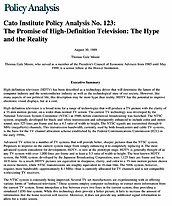High-definition television (HDTV) has been described as a technology driver that will determine the future of the computer industry and the semiconductor industry as well as the technological state of our society. However, like many aspects of our political life, this description may be more hype than reality. HDTV has the potential to improve electronic visual displays, but at a cost.
High-definition television is a broad term for a range of technologies that will produce a TV picture with the clarity of a 35-mm motion picture, on a wider-than-normal TV screen. The current TV technology was developed by the National Television System Committee (NTSC) in 1940, before commercial broadcasting was launched. The NTSC system, originally developed for black-and-white transmission and subsequently enhanced to include color and stereo sound, uses 525 lines per frame and has a 4:3 ratio of width to height. The NTSC signals are transmitted through 6‑MHz (megaHertz) channels. This transmission bandwidth, currently used by both broadcasters and cable TV systems, is the basis for the TV channel allocation scheme established by the Federal Communications Commission (FCC) in the early 1950s.
Advanced TV refers to a number of TV systems that will provide better, sharper pictures than the NTSC system. Proposals to improve on the current system range from simply enhancing it to completely replacing it. The most advanced system considered for development, HDTV, is now at the prototype stage. HDTV is generally thought of as any TV system with over 1,000 lines per frame and at least a 5:3 ratio of width to height. The best-known HDTV system, the NHK system, developed by the Japanese Broadcasting Corporation, uses 1,125 lines per frame and has a 16:9 ratio. As a result, HDTV pictures are equivalent in sharpness, clarity, and color to a 35-mm motion picture shown in movie theaters, while NTSC transmissions are roughly equivalent to 16-mm film. The NHK system, however, requires more bandwidth–approximately 8.1 MHz–than is currently allocated for TV channels and is not compatible withexisting TV receivers.
The NTSC system is constantly being improved. Several TV set manufacturers are experimenting with or offering various forms of “enhanced television.” These systems employ computer technology to extract more information from the current TV system. Some interpolate a line between every two lines in the current system, thus providing a simulated 1,050-line system. While this technology does provide a better picture, it fails to increase the amount of information that the home receiver will receive. Moreover, it does not provide any additional signal information to allow for a wider screen.
One difficulty with the current system is that motion pictures usually are made using a much wider aspect ratio than the 4:3 provided by the NTSC system. When a motion picture is broadcast, the TV editor must decide what part of the original picture–a bit from each side or all from one side–will be cut. When a motion picture is made for the theater, TV viewers often will notice that the ends of the titles or credits are cut off as a result of the reduced ratio.

This work is licensed under a Creative Commons Attribution-NonCommercial-ShareAlike 4.0 International License.
